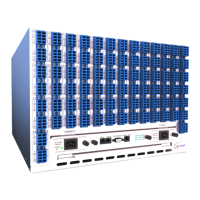CALIENT OCS WebGUI Quick Start Guide
Page 53 of 63
The InPortPower for an item listed on the Port Summary screen will be rounded up
or down to the nearest tenth when it is selected and displayed on the Port Detail
screen. For example, if a port with an input power of -5.77 dBm is selected from the
Port Summary screen, that value will be rounded to -5.8 dBm when it appears on the
Port Detail screen.
The In Port and Out Port sections of the Port Detail screen enable the user to monitor
the following information:
Input/Output Optical Power – the power, in decibel-milliwatts (dBm), on the
incoming/outgoing ports.
Input/Output Circuit ID – the circuit identifier of the incoming/outgoing ports.
AS – the administrative status of the incoming/outgoing ports; possible values are
IS (In Service) and UMA (Under Maintenance).
OS – the operational status of the incoming/outgoing ports; possible values are
RDY (ready), OOS (Out of Service) and OOS-NP (Out of Service-Not Provisioned;
Not Provisioned = Not Connected).
OC – the operational capability of the incoming/outgoing ports; possible values are
OK (connection is successful), INIT (connection is in-progress), FAIL (connection
is receiving no power or the connection setup has failed) and NOHW (No Hardware;
the port is not connected).
Owner – the type of operation that “owns” the port; possible values are TRANSIT
(the port is connected) and NONE (the port is not connected).
The Port Monitor Configuration section of the Port Detail screen enables the user to
monitor and adjust the following settings:
Input/Output Optical Power Degraded Threshold – the incoming/outgoing power
threshold, in decibel-milliwatts (dBm), beyond which the system will generate a
minor (MN) alarm.
Input/Output Optical Power Critical Threshold – the incoming/outgoing power
threshold, in decibel-milliwatts (dBm), beyond which the system will generate a
critical (CR) alarm.

